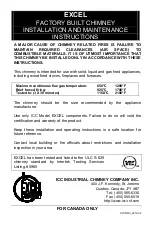
7
ENGLISH
Requirements for protection of
infl ammable fl oors in front of the fi replace
The front plate must comply with national laws and
regulations.
Contact your local building authorities regarding restrictions
and installation requirements.
3.3 Walls
Distance from the wall of fl ammable material
Distance to walls made of combustible material - see fi g.
1a
Distance to combustible wall protected by fi rewall: See
fi g. 1b
The fi replace can be installed with a minimum of 50 mm to
non-combustible wall if the distance from the fi replace to all
combustible materials are a minimum of 500 mm.
Non-combustible materials mean materials like brick, clinker,
concrete, mineral wool, cilicate plates etc (materials that do
not burn).
Note!
A short distance to non-combustible wall
may lead to desiccation and discoloration of paint and cause
cracking.
NB: Pay particular attention to this when using revolving
pedestal!
3.4 Ceiling
There must be a minimum distance of 750 mm to a combustible
ceiling above the fi replace.
Fresh air supply
The air used for combustion in any well-insulated house needs
to be replaced. This is particularly important in houses with
mechanical ventilation. Such replacement air can be procured
in several ways. The most important thing is to supply the air
to the room where the stove is placed. Place the outside wall
valve as close to the stove as possible and make sure that it
can be closed when the stove is not in use.
For the fresh air supply connection, follow the national and
local building regulations.
Important!
Ensure that air vents in the room where the
fi replace is located are not blocked.
Closed combustion system
Use the stove’s closed combustion system if you live in recently
built, airtight dwellings. Connect the external combustion air
through a ventilation pipe through the wall or the fl oor.
Air supply
The amount of combustion air for Jøtul’s products is approximately
20-40 m3/h. The outside air connection may be fi tted directly to
the Jøtul F 370 Advance through:
• the
bottom
• through
a
fl exible supply hose from the outside/chimney
(only if the chimney has its own duct for external air) and to
the product’s outside air connector.
Through an outside wall
Through the fl oor and ground plate
Through the fl oor and basement
Indirectly through an outside wall








































